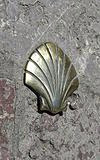The Credencial and Compostela
The compostela is a certificate of accomplishment given to pilgrims on completing the Way. To earn the compostela one needs to walk a minimum of 100 km or cycle at least 200 km. In practice, for walkers, the closest convenient point to start is Sarria, as it has good bus and rail connections to other places in Spain. Pilgrims arriving in Santiago de Compostela who have walked at least the last 100 km, or cycled 200 km to get there (as indicated on theircredencial), and who state that their motivation was at least partially religious are eligible for the compostela from the Pilgrim's Office in Santiago. At the Pilgrim's Office the credencial is examined for stamps and dates, and the pilgrim is asked to state whether the motivation in traveling the Camino was "religious", "religious and other", or "other". In the case of "religious" or "religious and other" a compostela is available; in the case of "other" there is a simpler certificate in Spanish.
The compostela has been indulgenced since the Early Middle Ages and remains so to this day. The full text of the certificate is in Latin and reads:
CAPITULUM hujus Almae Apostolicae et Metropolitanae Ecclesiae Compostellanae sigilli Altaris Beati Jacobi Apostoli custos, ut omnibus Fidelibus et Perigrinis ex toto terrarum Orbe, devotionis affectu vel voti causa, ad limina Apostoli Nostri Hispaniarum Patroni ac Tutelaris SANCTI JACOBI convenientibus, authenticas visitationis litteras expediat, omnibus et singulis praesentes inspecturis, notum facit : (Latin version of name of recipient)
Hoc sacratissimum Templum pietatis causa devote visitasse. In quorum fidem praesentes litteras, sigillo ejusdem Sanctae Ecclesiae munitas, ei confero.
Datum Compostellae die (day) mensis (month) anno Dni (year)
Canonicus Deputatus pro Peregrinis
English Translation:
The HEAD of the Holy Apostolic Metropolitan Church of Compostela, guardian of the seal of the Holy Altar of the Apostle James, to all Faithful and Pilgrims from all the earth who come with feelings of devotion or vowed to a cause to the threshold of the Apostle, both our Patron of Spain and Protector St. James, by authenticating the letters of each and every visitation, makes known that [Name] has devoutly visited this Sacred Church on a pious cause. In whose strong faith this letter is presented, with the seal of the same Holy Church, conferred upon them.
Given at Compostela on the day [day] month [month] year of the Lord [year].
Deputy Canon for Pilgrims
Source: Wikipedia





